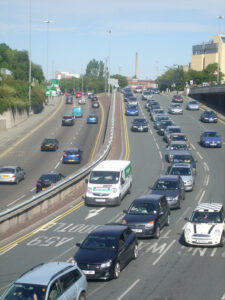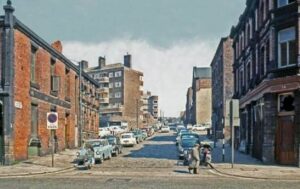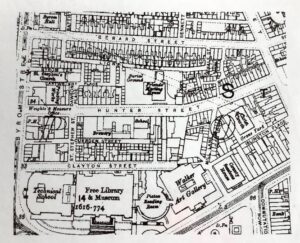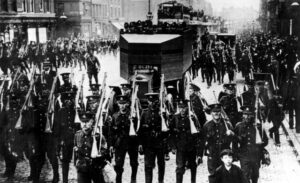You wouldn’t recognise it anymore. Anonymous, a dual carriageway. That stretch, behind the Walker and Museum. From Islington and down to Byrom Street. An endless stream of vehicles, both ways. In one, towards the eastern suburb sprawl, the motorway and hated Manchester, the two cathedrals, Toxteth and the south. The other? Mersey Tunnels and the north. Or Dale Street, to the windswept Pier Head, the ferries, and some mystic Sixties song.
But then, a hundred years ago and more, how near to revolution’s part it played.
More modest, yet more interesting by far. All terraced houses, businesses and shops. A maze of smaller thoroughfares and dives where, later, Gerard Gardens would be built. Built only to be ripped back down again. To make way for some sterile urban sprawl.
So, join me, in that Hunter Street of old. Before the present highway’s diesel fumes. Nineteen Eleven, just to be precise. A boundary. No man’s land. The old frontier. Sectarian divides, all hues and cries.
Nineteen Eleven and the transport strikes. An August Bloody Sunday afternoon, of sun-soaked protest, speech and tragedy. St. George’s Plateau, filled to bursting point.
A rally crowd, one hundred thousand strong, of seamen, dockers, carters and the rest. Their families, the mothers and the kids. And suffragettes with sash and banner bright. ‘God Bless Tom Mann!’ and ‘Solidarity!’
Too close to insurrection for the Mayor, for London – Churchill as Home Secretary. The army called, and police from Birmingham. Repeated baton charges, broken heads. The wounded. Women. Children. Innocents. The Riot Act read, just as afterthought.
A running battle, two days long or more as martial law invaded hearth and home. So, barricades, defence committees formed. On Christian Street. On Hunter Street as well.
The Magistrates sent men to Walton Gaol in Black Marias flanked by mounted troops. Just two days later, August the Fifteenth. But crowds had gathered, protests on the route, near Hopwood Street along old Vauxhall Road. They say that stones were thrown, the horses shied, but those Hussars replied with rifle fire. Two men shot dead – one in his own front room and hanging curtains for his new young wife. There was, of course, an inquest of a sort. The verdict? Homicide and justified.
Yet, bit by bit, the strikers won their fight. The seamen, dockers, carters and the rest. The tramway workers too – at least in part. September came and went. Tom Mann went too. The trams ran once again down Hunter Street, past lodgings, past Christ Church, the Registrar – for Islington – the Quaker Meeting House. Tobacco warehouse. Mellor’s Brewery. The bottom corners, printer Bill McCall, the Weights and Measures place while, opposite, the Byrom pub, though known as Old Mad John’s.
All gone now, nothing left but traffic jams. So, next time, when you’re stuck there, heading home – that stretch behind the Walker and Museum – maybe remember how it once had been. On Hunter Street, its place in history.




Really enjoyed reading this.
I had a relative who I traced at 23 Hunter St in 1860’s (roughly) onwards. He died in 1881 but was mentioned in newspapers advertising for renting and selling public houses. Some of the adverts said his contact was Hunter St/Byrom St, I’m presuming it was a corner building.
Hi Pipsy. Interesting. 23 Hunter Street was a fair way up on the left hand side, of course (heading up from Byrom Street). But on the corner of Hunter Street and Byrom Street, as you may know (the corner nearest town), was the Byrom pub (aka Mad John’s), so maybe that was the contact for his business dealings? Nice link, though. I’m doing a show about all this Hunter Street stuff (Liverpool 1911) at MerseyMade on Paradise Street this coming Thursday (11th) at 2.30pm. What was your relative’s name?
I’m sorry I never checked for a reply before now as I presumed I would be informed via email.
I think you are indeed correct as it makes perfect sense. I am laughing that I never even thought of it.
Sorry I missed your talk as I’m sure it would have been interesting.
My relative was John Brook Durrans. I have found out quite a bit about him, he was originally from Huddersfield.
Thank you for taking time to reply, much appreciated.
Hello again. And no problem. To be honest, I often forget to check on here for comments as well. I haven’t got any more “Liverpool 1911” talks coming up but probably in the New Year. Details usually in my newsletters. Meanwhile, great news that you’ve tracked down John Brook Durrans. I’m not sure if you know, but there’s usually somebody in Liverpool Central Museum who helps with family history. They’re usually great at digging down to further levels of information (newspaper records, etc).
Will check in again next year then see if I can make any talks you do.
Thanks about the library, I was aware but good to be reminded.
Cheers
No problem. And yes, of course I meant Liverpool Central Library!
I’ve Just found this page regarding Hunter Street, my family (Benson) lived at 23 Hunter Street, was it a boarding house as there seemed to be a large amount of people living there
I’d love to find out more about the address
Hi Albert. Good to hear from you. Likely a boarding house, as you say. Just checked the 1921 Census. In that year, there were 7 batches of occupants living there – though I can’t find any Bensons: (1) George Bryan (60), a widower working for White Star: (2) Thomas Williams (55), a ship’s scaler, and his 2 daughters; (3) Samuel Whitehead (74), a widower; (4) Frank Smith (51), a general porter, with his wife and son; (5) Samual Whitechurch (48), a general labourer, with his wife and son; (6) Maude Warner (57), a widow; and (7) Ivy Jones (23) with her son (2). Many of them are still there in 1939. Lots of the other houses along that part of Hunter Street are also multiple occupancy. Was your family there later??